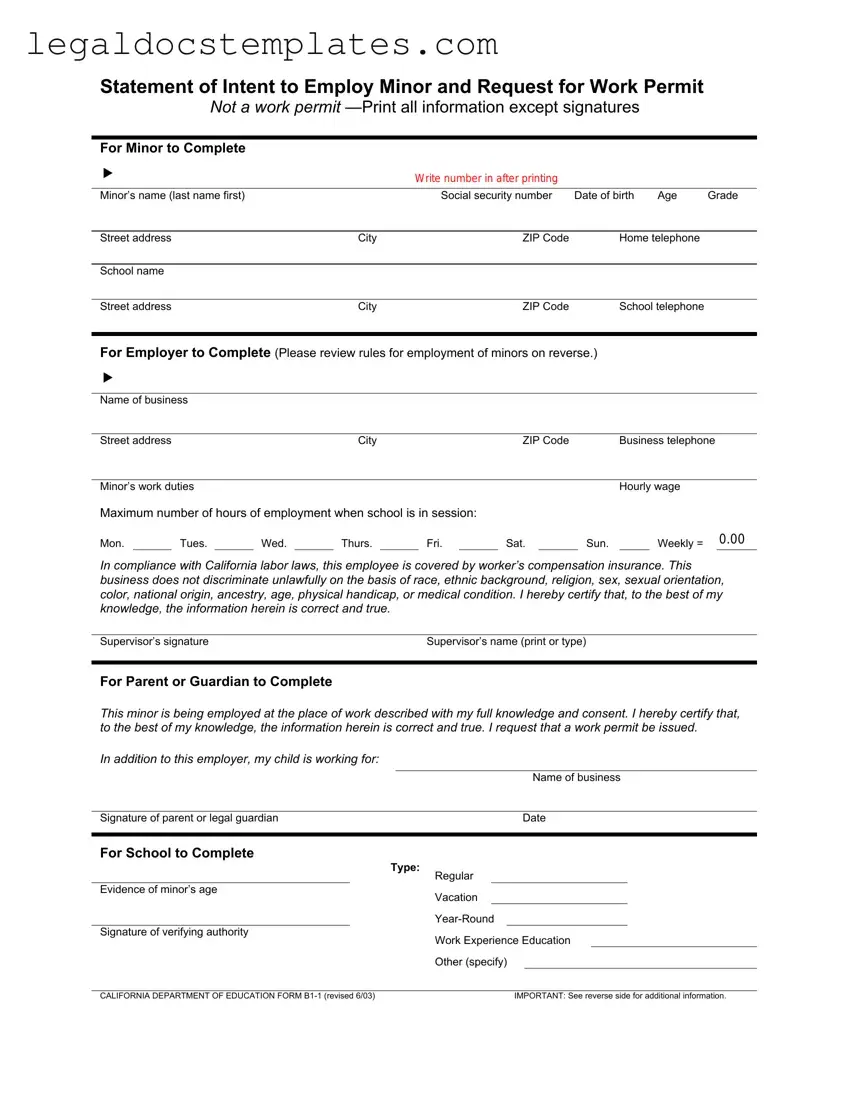•If federal laws, state laws and school district policies conflict, the more restrictive law (the one most protective of the employee) prevails.
•Generally, minors must attend school until age 18 unless they are 16 years or older and have graduated from high school or received a state Certificate of Proficiency.
•Employers of minors required to attend school must complete a “Statement of Intent to Employ Minor and Request for Work Permit” (form B1-1) for the school district of attendance for each such minor.
•Employers must retain a “Permit to Employ and Work” (form B1-4) for each such minor.
•Work permits (B1-4) must be retained for three years and be available for inspection by sanctioned authorities at all times.
•A work permit (B1-4) must be revoked whenever the issuing authority determines the employment is illegal or is impairing the health or education of the minor.
Minors under the age of 18 may not work in environments declared hazardous or dangerous for young workers as listed below:
1.Explosive exposure
2.Motor vehicle driving/outside helper
3.Coal mining
4.Logging and sawmilling
5.Power-driven woodworking machines
6.Radiation exposure
7.Power-driven hoists/forklifts
8.Power-driven metal forming, punching, and shearing machines
9.Other mining
10.Power-driven meat slicing/processing machines
11.Power-baking machines
12.Power-driven paper products/paper bailing machines
13.Manufacturing brick, tile products
14.Power saws and shears
15.Wrecking, demolition
16.Roofing
17.Excavation operation
For more complete information about hazardous occupations, contact the U.S. Department of Labor (Child Labor Bulletins 101 and 102) and the California Department of Industrial Relations, Division of Labor Standards Enforcement. Regional offices are located in several California cities. They are listed in the “Government Listings” sections of telephone directories.
•Minors younger than 16 years are allowed to work only in limited, specified occupations that exclude baking, manufacturing, processing, construction, warehouse, and transportation occupations.
•In addition to safety regulations, labor laws applicable to adult employees also generally apply to minor employees, including workers’ compensation insurance requirements.
•Child labor laws do not generally apply to minors who deliver newspapers or work at odd jobs, such as yard
work and baby-sitting, or in private homes where the minor is not regularly employed.
•A day of rest from work is required if the total hours worked per week exceed 30 or if more than 6 hours are worked on any one day during the week.
16 – 17 When school is in session: Daily maximum of 4 hours, Monday through Thursday. May work up to 8 hours on any non-school day or on any day that precedes a non-school day. May be permitted to work up to 48 hours per week. Students in Work Experience Education or cooperative vocational education programs may be permitted to work a maximum of 8 hours on a school day.
When school not in session: May work up to 48 hours per week but no more than 8 hours in any one day.
Work must be performed no earlier than 5 a.m. or later than 10 p.m. except that work may extend to 12:30 a.m. on nights preceding non- school days. Students in Work Experience Education or cooperative vocational education programs may be authorized to work until 12:30 a.m. on nights preceding school days with specified written permission.
14 – 15 When school is in session: On school days daily maximum 3 hours. On non-school days may work 8 hours. Weekly maximum of 18 hours. Students in Work Experience Education and career exploration programs may work up to 23 hours per week.
When school is not in session: Daily maximum 8 hours and weekly maximum 40 hours.
May not work during public school hours except students in Work Experience Education or career exploration programs.
Work must be performed no earlier than 7 a.m. nor later than 7 p.m. any day of the week. From June 1 to Labor Day work hours may be extended to 9 p.m.
Younger Labor laws generally prohibit nonfarm than 14 employment of children younger than 14.
Special rules apply to agricultural work, domestic work and the entertainment industry.


